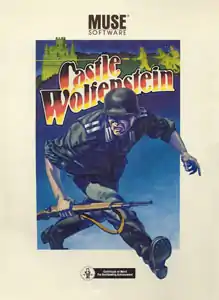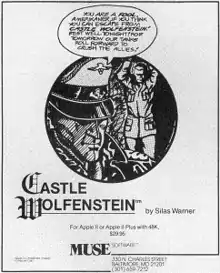Castle Wolfenstein
Castle Wolfenstein is a stealth-based, action-adventure game developed by Muse Software for the Apple II and published in 1981. It was initially ported to the Atari 8-bit family, Commodore 64, and MS-DOS. At the start of the game, the player is held in Nazi headquarters during World War II: Castle Wolfenstein. Given a gun and ten bullets by a prisoner, the player's goal is to escape.
| Castle Wolfenstein | |
|---|---|
 | |
| Developer(s) | Muse Software |
| Publisher(s) | Muse Software |
| Designer(s) | Silas Warner |
| Series | Wolfenstein |
| Platform(s) | Apple II, MS-DOS, Atari 8-bit, Commodore 64 |
| Release | September 1981: Apple 1983: Atari, C64 1984: MS-DOS |
| Genre(s) | Stealth, action-adventure |
| Mode(s) | Single-player |
With limited ammunition and an emphasis on avoiding detection, Castle Wolfenstein is considered a prototypical stealth-based game. A sequel, Beyond Castle Wolfenstein, was released in 1984. The series inspired the 1992 first-person shooter Wolfenstein 3D.
Plot
An Allied spy has been captured and taken to Castle Wolfenstein for interrogation by the SS and is subsequently thrown into the dungeon. A dying prisoner emerges from a hiding place and in his last moments, hands the spy a fully loaded Mauser C96 pistol. The spy proceeds to escape the dungeon, steal the battle plans from the officers' headquarters, and leave Castle Wolfenstein.[1]
Gameplay
Castle Wolfenstein is a stealth-based, action-adventure shooter game set in World War II. The main objective is to traverse the castle's levels to find secret war plans and escape alive. Sixty discrete rooms are located on five separate floors. Although the rooms' internal contents are shuffled at the beginning of each game, the path through the castle always remains unchanged. Progressively higher ranks are earned upon each successful escape with the plans; the game becomes more difficult as each higher rank is achieved. The eight ranks range from private to field marshal.

The game is played from a top-down perspective, though the characters are upright like in a side-scroller. The player traverses the levels by sneaking past, impersonating, and killing Nazi soldiers. Castle Wolfenstein can be played with a joystick, paddles, or a keyboard.
The player starts the game with a gun and ten bullets.[2] Once the player starts moving, he attracts the guards' attention, who try to shoot or apprehend him. He must either run from the guards or kill them. There are two types of guards in Castle Wolfenstein: standard guards and SS Stormtroopers, who can be identified by their bulletproof vests marked with the SS insignia. The standard guards react to the sounds of gunshots and grenades--or after seeing the player without a uniform. They will walk their patrol paths into raised guns and surrender to a search. Additionally, they are unable to leave the rooms where they are stationed. The SS guards are more active, roaming from room to room and once alerted, will chase the player until they die or kill the player.[2] They require a larger number of bullets or a grenade to kill.[2]
The player can kill enemies by firing the pistol (which expends ammunition, a scarce commodity, and risks raising the alarm if another guard is present) or throwing a grenade (though this will also attract the attention of nearby guards). Once an enemy soldier is dispatched, his body can be searched for ammunition, keys, grenades, and bulletproof vests. If the player reaches maximum carrying capacity, any remaining ammo and grenades are left on the body. To avoid detection, the player can find a uniform (either in a chest or from a dead guard), which will convince the standard guards that the player is one of them. However, the SS guards usually expose the player as an impostor. Pulling a gun on a guard usually causes him to put his hands up, allowing him to be frisked for ammo, bulletproof vests, grenades, and keys. Any quantity over the player's carrying capacity disappears. Optionally, the player can kill the guard at this point.[2]
Some rooms contain locked chests that can be opened and searched by standing in front of the chest to pick its lock, firing a gun at it, or using a key.[2] Some chests are empty but others have useful items such as bullets, grenades, uniforms, bulletproof vests, or war plans.[2] Chests may also contain Bratwurst, Liebfraumilch wine, Schnapps, Eva Braun's diaries, cannonballs, and medals. If the player fires a gun at a chest containing explosives, the game ends.[2] After a player eats a Bratwurst, the character will comment "Awful!"[2]
Other than the room's outer walls and the stairs, the entire room is destructible using grenades. This can be helpful to access a chest from another direction if a body has fallen in front of it; searching a body has precedence over opening a locked chest. Chests can also be destroyed with a grenade, but if it contains explosives (bullets, grenades, or cannonballs), it will explode and end the game.
Running into walls temporarily stuns the player but vertical walls can be clipped slightly by the player's motions and not stun them. Some horizontal walls can be contacted from the side without effect. Dead guards can allow the player to walk through horizontal wall segments and chests, albeit not from directly below. Surviving standard and SS guards cannot step over bodies, so they can be used to block passage to areas of the room, trap guards in cul-de-sacs, or block the entry of an SS guard.
German words are shouted by the guards such as "Halt!" ("Stop!") and "Kommen Sie!" ("Come here!").
Development

Silas Warner was inspired to create Castle Wolfenstein after seeing the video game Berzerk at an arcade and subsequently watching the 1961 film adaptation of The Guns of Navarone on television a few weeks later.[3]
Reception
Debuting in September 1981, Castle Wolfenstein had sold 20,000 copies by June 1982.[4] Creative Computing Video and Arcade Games criticized the Apple version's slow gameplay but concluded, "the thrill of the escape is worth the wait."[5] Ahoy! critiqued the Commodore 64 version's slow load times and annoying wall-collision detection, but called Castle Wolfenstein "...addicting. I am not all that big on killing everything that moves, but I really got caught up in the adventure."[2] Antic commented on the Atari 8-bit version's use of the Apple II original's "lousy sound and black-white-green-purple graphics."[6]
The Apple II version received a Certificate of Merit in the "Computer Game of the Year" category at the fourth annual Arkie Awards.[7] A 1991 Computer Gaming World survey of strategy and war games gave Castle Wolfenstein one and a half stars out of five.[8] However, in 1996, the magazine named Castle Wolfenstein the 116th best game ever.[9]
Legacy
Castle Wolfenstein became so popular that by 1984 at least one commercial game trainer for a video game was created for it.[10] Muse released a sequel, Beyond Castle Wolfenstein, which is similar in gameplay and appearance. The objective is to assassinate Adolf Hitler with a bomb hidden in a briefcase, similar to the 20 July plot led by Claus von Stauffenberg as part of Operation Valkyrie.
Castle Wolfenstein inspired the game Wolfenstein 3D and its sequel Spear of Destiny by id Software,[11] which were both released in 1992 and helped popularize the first-person shooter genre. id Software went on to release Return to Castle Wolfenstein in 2001, Wolfenstein: Enemy Territory in 2003, and Wolfenstein in 2009. Wolfenstein: The New Order used the id Tech 5 game engine but was developed and published by MachineGames and Bethesda Softworks respectively and released in 2014.
A 1983 hack named Castle Smurfenstein, which replaces the Nazis with Smurfs,[12] is regarded as one of the earliest examples of the art mod.[13]
See also
 1980s portal
1980s portal Video games portal
Video games portal World War II portal
World War II portal
References
- "Castle Wolfenstein advert". Computer Gaming World. No. 1. Golden Empire Publications. December 1981. p. 5.
- Herring, Richard (June 1984). "Castle Wolfenstein". Ahoy!. pp. 57–58. Archived from the original on 4 April 2016. Retrieved 27 June 2014.
- Olson, Mathew (26 October 2017). "The Best Way to Experience the 'Wolfenstein' Games". Digg. Archived from the original on 19 August 2019. Retrieved 16 January 2020.
- "Inside the Industry" (PDF). Computer Gaming World. September–October 1982. p. 2. Archived from the original on 2016-04-04. Retrieved 2016-03-28.
- Ahl, David H.; Brill, Andrew; Lubar, David; Coffey, Michael; Archibald, Dale (Spring 1983). "Apple Computer Games". Creative Computing Video & Arcade Games. Vol. 1 no. 1. p. 86. Archived from the original on 2017-11-07. Retrieved 2017-11-06.
- Bernstein, Harvey (May 1985). "Beyond Castle Wolfenstein". Antic. p. 83. Archived from the original on 15 March 2016. Retrieved 8 January 2015.
- Kunkel, Bill; Katz, Arnie (March 1983). "Arcade Alley: The Best Computer Games". Video. Vol. 6 no. 12. Reese Communications. pp. 32–33. ISSN 0147-8907.
- Brooks, M. Evan (November 1991). "Computer Strategy and Wargames: The 1900-1950 Epoch / Part I (A-L) of an Annotated Paiktography". Computer Gaming World. p. 138. Archived from the original on 2 December 2013. Retrieved 18 November 2013.
- "150 Best Games of All Time". Computer Gaming World. November 1996. pp. 64–80. Archived from the original on 8 April 2016. Retrieved 25 March 2016.
- "If they won't fix Castle Wolfenstein, we will" (PDF). Computer Gaming World. Vol. 4 no. 1. February 1984. p. 15. Archived (PDF) from the original on 2 October 2014. Retrieved 17 April 2016.
- Plunkett, Luke. "In Memory of the Original Castle Wolfenstein (the one That Wasn't In 3D)". Kotaku. Archived from the original on 9 July 2013. Retrieved 24 December 2011.
- "Triumph of the Mod". Salon. 2002-04-16. Archived from the original on 2015-07-03. Retrieved 2013-04-01.
- Bogacs, Hannes. Game Mods: A Survey of Modifications, Appropriation and Videogame Art. Vienna University of Technology - Design and Assessment of Technologies Institute. February 2008.
External links
- Castle Wolfenstein at MobyGames
- Castle Wolfenstein can be played for free in the browser at the Internet Archive
